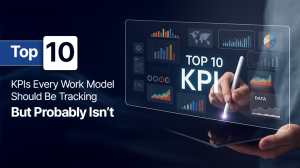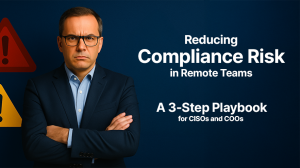In 2025, the remote work model will be leveraged for its flexibility and cost-effectiveness. Remote culture is the future of modern workforces. A report from CXO Today estimated that 60-90 million Indians will be working remotely by 2025.
Monitoring the remote workforce is one of the biggest challenges for today’s businesses due to lack of visibility and control over daily operations. Whether employees are staying productive or streaming Netflix during work hours, you need clarity. Monitoring employees is crucial, especially in remote environments, to ensure consistent performance, accountability, and security compliance.
Remote productivity monitoring tools can be your partner to clarify the blurry boundaries of employee tracking. It automatically tracks employees’ time, performance, activity, and security adherence without sacrificing their privacy. It helps managers analyze productivity trends and identify areas for improvement.
With AI-powered security and real-time tracking, employee monitoring has become easy for businesses, whether they have a remote, hybrid, or in-house team. However, ethical concerns are always a headache for HR and employees, especially regarding privacy and security concerns.
Keep reading to know how remote productivity monitoring tools can help you to boost productivity, ensure transparency, and allow you to lead distributed teams with confidence and clarity from anywhere.
What are Remote Employee Monitoring Tools?
Remote employee monitoring software automatically observes and analyzes employees’ activities, efficiency, and security compliance. It enables businesses to access real-time performance data and make informed, data-driven decisions to streamline their operations.
Whether SMBs, startups, or global giants use employee monitoring tools to track and ensure remote employees remain productive and adhere to compliance policies. 60% of companies use remote monitoring tools to track:
- Get real-time insight into website usage, productivity trends, and project processes.
- Identify potential roadblocks and areas of improvement.
- Protect sensitive data and comply with HIPAA and SOC-2.

See in Action How wAnywhere Simplifies Remote Monitoring for Your Business
Experience real-time insights, ethical tracking, and productivity boosts tailored to your team’s needs.
Benefits of Monitoring Remote Employees
It became a critical strategy partner for the modern workforce seeking an all-in-one solution to boost productivity and streamline operations. Here are some proven benefits of using workforce tracking software for remote workforces.

- Ensure Alignment with Goals and Deliverables
Sticking to business goals is crucial for scalable operations. Remote tracking provides clarity on whether an individual’s performance is aligned with business goals or not.
Businesses can access these parameters by tracking website usage, productivity patterns, and project progress.
- Identify Productivity Gaps and Roadblocks
Social media, constant notifications, and home noises are common distractions for the remote workforce. It can hinder the productivity and focus of employees. Remote employee monitoring tools automatically provide real-time alerts on website usage and productivity patterns.
It identifies potential productivity gaps and roadblocks to make data-driven policies to keep remote workforces on track.
- Maintain Accountability without Micromanagement
It allows managers to build accountability on employees for their tasks, knowing that they are constantly being tracked. With real-time insight into employees’ activity, it reduces the need for micromanagement. It fosters accountability and allows employees to focus on assigned projects. It also eliminates the risk of burnout and ensures the workforce is on track.
- Support performance Reviews with Real-time Data
Remote productivity tracker, real-time data on employees’ performance, project-based delivery, and consistent performance. It allows managers to support fair assessment, performance-based promotions, and training employees.
5 Best Practices to Monitor Remote Employees

Remote Productivity monitoring tools offer numerous benefits, including improving productivity, efficiency, security compliance, and reducing burnout. However, businesses must implement these 6 best practices to leverage the peak benefits of this tool.
1. Set Clear Expectations & KPIs
Define roles, responsibilities, working hours, and communication protocols in writing. Establish SMART KPIs tailored to each role. It ensures remote employees seek accountability for their role and have clarity on how performance is evaluated. It also helps managers stay focused on outcomes instead of micromanaging daily tasks.
2. Use the Right Remote Productivity Monitoring Tools
Monitoring a remote team becomes effortless with the right remote productivity monitoring tools. Choose a solution specifically built for managing distributed teams to ensure ethical and transparent tracking. The best remote employee monitoring software integrates seamlessly with project management and communication platforms, enabling smoother workflows, stronger collaboration, and real-time visibility into employee activities. With features like visual dashboards, activity summaries, and performance metrics, these tools help you stay on top of team productivity without micromanaging.
3. Schedule Regular Check-ins
Schedule weekly one-on-one meetings to understand individual progress and address blockers. Use tools like Microsoft Teams or Slack for consistent and structured check-ins. It helps build trust, maintain accountability, and provide opportunities for feedback. They also make employees feel connected, reducing feelings of isolation.
4. Monitor Outputs, Not Just Activity
Instead of focusing on screen time or mouse clicks, shift your monitoring strategy to outcomes. Evaluate employees based on the quality and timeliness of their work. Measuring KPIs such as completed projects, client satisfaction, and goal achievements offers a better view of productivity than just an online presence.
5. Encourage Self-Reporting
Ask remote employees to submit brief daily or weekly updates summarizing their accomplishments, priorities, and any blockers they’re facing.
This practice keeps managers informed and encourages employees to reflect on their progress. Self-reporting improves mutual trust, improves time management, and promotes goal alignment. It’s a simple yet effective habit that increases engagement and makes monitoring less about control and more about collaboration.

Discover the full potential of wAnywhere’s remote work employee software
Unlock smarter ways to manage productivity, compliance, and security—wherever your team works.
Read More: How To Monitor Employee Productivity
Ethical Considerations in Remote Monitoring
Employees should always be informed about what is being tracked, how the data is used, and who has access to it.
Open communication builds trust and reduces the fear of surveillance. It’s best to include monitoring practices in company policies and discuss them during onboarding or team meetings.
It’s crucial to create a balance between productivity and privacy. Monitoring tools should focus on work-related metrics, not private data.
Businesses must ensure their monitoring tools and practices align with local laws to avoid legal issues and protect employee rights.
Companies can create a culture of accountability without compromising employee dignity by prioritizing ethical monitoring. Employee tracking tools like wAnywhere allow managers to monitor productivity while maintaining transparency and respecting privacy, making them a smart choice for remote-first organizations.
Common Mistakes to Avoid in Monitoring Remote Employees

1. Over-Monitoring and Micromanagement
Too much monitoring can feel invasive and damage trust. When employees are constantly tracked, it creates stress and reduces motivation. Instead of tracking every move, focus on outcomes and deliverables.
Balance is key; monitor performance, not attendance, to encourage a healthy and productive remote work environment.
2. Not Communicating the Purpose of Monitoring
Failing to communicate the purpose creates confusion and resistance. Always explain what is being tracked, how the data will be used, and the benefits to both the company and the team. Transparent communication builds trust and ensures that everyone is on the same page.
3. Using Tools That Invade Privacy
Avoid monitoring tools that collect excessive personal data, like screenshots of private messages or webcam access, which can cross ethical boundaries. Such tools create discomfort and legal risks, especially in regions with strict privacy laws.
Always choose monitoring software that respects employee boundaries and focuses on work-related metrics.
Read more : How to find Right Employee Monitoring Software
Monitor Remote Workforce the Right Way with wAnywhere
wAnyhwere is an all-in-one remote employee monitoring software designed for the modern workforce that operate remotely, in hybrid or on-site modes. It offers real-time workforce analytics to help you lead better with actionable data, not guesswork. It provides you accurate insights on how, where, and when your employees work, so you can optimize resources, balance workloads, analyze work trends, and improve overall efficiency.
Real-time insight on employees’ performance, idle time, website usage, and project progress.
Help managers identify productivity trends and bottlenecks to streamline workflow.
Our AI-powered security sends instant alerts for mobile detection, unauthorized access, and suspicious activity to prevent data breaches.
Its API-first approach seamlessly integrates existing software and communication channels to ensure hassle-free installation. That too in just 5 minutes, without disturbing the workflow.
The smart ethical monitoring track only works with data to make sure the remote workforce doesn’t stress their privacy, and businesses comply with regulatory bodies like HIPAA, SOC-2, and GDPR.
Read more : 6 Best Employee Monitoring Software in 2025
Conclusion
Monitoring your remote employees’ performance, activity, and security parameters is necessary for businesses. Remote productivity monitoring tools provide real-time insight to help managers identify roadblocks and streamline business operations.
In the above blog, we have discussed how these proven practices can help them counter the challenges of remote workforce monitoring without crossing ethical boundaries set by regulatory bodies.
However, the secret to efficient employee tracking depends on setting clear objectives and selecting ethical workforce productivity monitoring software to boost productivity, accountability, and ensure compliance.

Start Your Free 14-Day Trial — Ethical Remote Monitoring Made Simple
Track productivity and ensure compliance with full transparency—no micromanagement, no privacy concerns.









